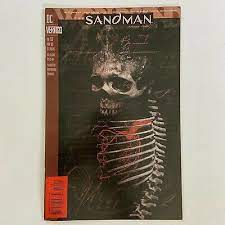earth burial;
fire;
mummification;
water;
air burial.
We will look at the air burial variants:
Petrefax: ...dismemberment and otherwise; ingestion by raptors or scavengers; complete or partial disposal.
-Neil Gaiman, "Cerements" IN Gaiman, The Sandman: Worlds' End (New York, 1994), pp. 116-138 AT p. 118, panel 9.
And that leads neatly back to Poul Anderson's The People Of The Wind. What method of disposal can the winged Ythrians use but air burial? However, Petrafax meant merely exposure to the air, and maybe to some of its inhabitants, but what can the Ythrians do except fly the body on its litter as high as possible over the mountains, then let it go? This seems appropriate for them.

9 comments:
Kaor, Paul!
And I would disagree with how Ythrians "dispose" of their dead. Bluntly, it's LITERALLY dumping the bodies to be devoured by scavengers or decompose any old way. I far prefer the ways most humans do it, either burial or cremation. And I recall how light rays from other stars would lap on Emperor Georgios' tomb, and how Kossara Vymezal's remains were interred in a tomb after lying in honor in St. Clement's Cathedral.
Ad astra! Sean
Leaving the body for scavengers is quite common in human cultures, though a distinct minority. Mongols and many Indian tribes here in the Americas did that.
Kaor, Mr. Stirlng!
I should have cited those examples. And the Zoroastrian Parsees of India would place their dead in towers open to the sky for scavenging birds to eat.
But, as you said, such customs among humans were only used by a minority, the preference being for more respectful or ceremonious disposing of the dead.
Ad astra! Sean
Sean: it’s also a matter of practicality. Mongols couldn’t cremate their dead (since the only widely available fuel was dried dung) and burial was difficult and expensive, mostly reserved for khans and chiefs.
The Mongol name for the local vultures was “soul-carrier”.
As so often is the case, it’s a matter of “nomos is king”, as Herodotus put it — nomos meaning ‘arbitrary local custom’.
My own viewpoint can be summed up in a quatrain:
So, some to the Earth do give their dead;
And some to the cleansing fire
But since I won’t be here to see
You can use my guts to string a lyre.
Kaor, Mr. Stirling!
Except for when the ground was frozen during the winters, I would not have thought it that hard for Mongols to dig graves. I'm sure they knew how to use mattocks and shovels.
Amusing, that verse you quoted, but I disagree with it. Because I believe your spirit will survive bodily death.
Ad astra! Sean
Sean: if your spirit survives death, why be concerned with the disposal of its temporary and now discarded container?
Kaor, Mr. Stirling!
Because everything that is merely material are still good things! And because the bodies of intelligent beings housed immortal spirits. If our bodies are good things, then they should be treated with respect after death. That is why the Catholic Church includes burial of the dead among the corporal works of mercy.
Ad astra! Sean
But IIRC, the fate of the body doesn't affect the soul's chances of salvation; and it's going to decay to nothing anyway.
(My family mostly practices cremation.)
Kaor, Mr. Stirling!
Of course, just stating the Catholic POV. And while the Church no longer opposes cremation, per se, she does insist on the cremains being buried respectfully.
Ad astra! Sean
Post a Comment